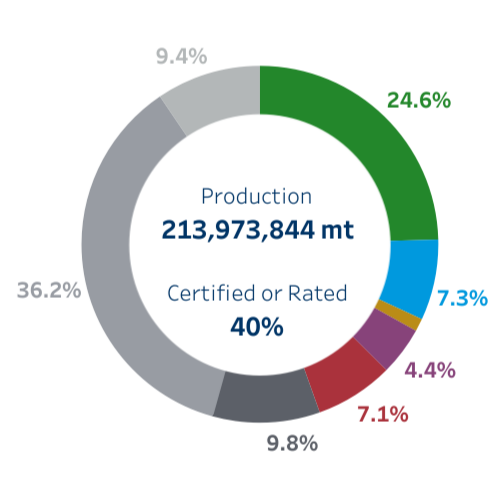We recently released an update to the Collaboration’s Sustainable Seafood Data Tool, offering the most complete picture ever of the sustainability performance of worldwide seafood production.
The new release shows that the reach of contributing programs increased from 38% of global production in 2020 to 40% in 2022. Worldwide production was nearly 214 million metric tons in the 2022 version of the tool.
Collaboration members and the Global Seafood Alliance’s Best Aquaculture Practices program (BAP) contribute data to the tool. Since 2020, these organizations have expanded the reach of their programs:
- ASC certified volumes have increased – farmed shrimp from Ecuador, oysters in China and France, and salmon in Iceland, in particular – as have farms in assessment and in AIPs through ASC’s Improver Programme pilots
- BAP farm production grew as did the number of producers and supply chain actors certified, as the Global Seafood Alliance added farms, hatcheries, feed mills, processors and fishing vessels
- FIPs volume increased, especially in marine ingredients and the establishment of new mackerel, herring, and blue whiting FIPs aimed at addressing management issues that resulted in the loss of their MSC certification
- FTUSA added 4 new certified fisheries, 3 new countries, and a total of 19 supply chains
- MSC launched its revised Capture Fisheries Standard 2.0.0 and increased the number of fisheries engaged in the program by 29
- Seafood Watch completed or updated 176 ratings including notable upgrades to yellow for some farmed Atlantic salmon from Chile, Norway, and Nova Scotia, and downgrades to red for farmed Atlantic salmon from British Columbia and dolphinfish from Costa Rica, Panama, and Ecuador
The new release also sharpens the data tool’s resolution, by adding a new Data Deficient (nei) Species Groups category, spotlighting generic species groups reported to the United Nations’ Food and Agriculture Organization. The four species groupings identified by the tool as data deficient make it impossible to assess the status of about 10% of global production, the majority of which is from wild capture fisheries in Asia. Until these countries improve their data collection and reporting, about 20 million metric tons of production will remain a sustainability black hole.
The tool also adds a new Data Deficient (nei) Species Groups filter, allowing users to see how nei reporting undermines efforts to understand and improve the sustainability performance of worldwide seafood production.
Finally, the updated tool also shows nearly 8% of global production in assessment. With most of those assessments and ratings scheduled for completion this year, the next data tool update should provide an even more comprehensive snapshot.
The data tool includes a feedback form. After checking out the tool, please let us know what you like most about it and how we could make it even better.

